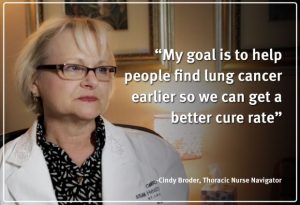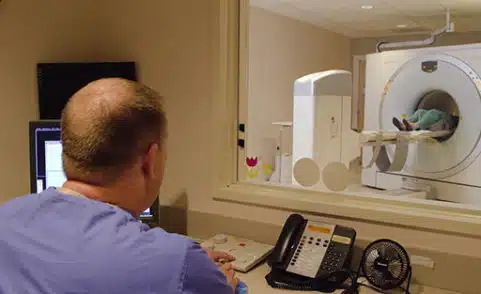
Detecting Lung Cancer with a Low-Dose CT Scan
The deadliest cancer for both men and women is lung cancer. While many people have the perception that lung cancer is a smoker’s disease, 1 in 5 women who have never smoked and 1 in 13 men who have never smoked will get lung cancer. Cindy Broder of SSM Health, a RAYUS partner, is on the front lines of this deadly disease and sees these statistics play out on a daily basis as a Thoracic Nurse Navigator.
“Only 16 percent of lung cancers are found in the early stage, when it’s most treatable,” Cindy explains. “That’s a really important fact because there are no signs or symptoms of lung cancer and when you do start developing signs of lung cancer, like a cough or coughing up blood, it’s more advanced.” This is why lung cancer screening is critical – more patients have the chance to have cancer diagnosed at a treatable stage.
A Personal Guide Through Lung Cancer
As a Thoracic Nurse Navigator, Cindy’s main focus is to follow a patient from diagnosis through treatment. She’s there to answer patients’ questions about their scans, treatment and who they should be going to next. And she’s always ready with more information about the diagnosis. It’s the type of support that is invaluable to a patient coping with this deadly type cancer.
“Whenever you get a cancer diagnosis, that’s scary and you need to have a support person – somebody to be there and hold your hand,” says Cindy. “That’s really important. My goal is to help people find lung cancer earlier so we can get a better cure rate”.
Many people think 1.) What they don’t know won’t hurt them and 2.) You can’t get lung cancer if you’ve never smoked. Neither are true. But Cindy says those false beliefs are why lung cancer screening should be part of your yearly discussion with your physician, along with prostate and breast cancer screening.
Getting Screened for Lung Cancer
The lung cancer screening is a quick and painless exam. Dr. Megan Gau, a Diagnostic Radiologist at RAYUS, says to image your lungs, they use a low-dose CT protocol. “We really focus on looking at masses in the lung,” Dr. Gau explains. “Sometimes we see little things that are too small to biopsy but we’re able to see on the CT and we follow along very closely to see if they would develop into anything or if it’s just a natural benign process in the lung.” If your doctor can identify those nodules in your lung early and then track changes, you’re more likely to detect lung cancer at an early and more treatable stage.
For many years, radiologists and physicians have relied on chest x-rays, which are a global low-resolution view of the chest. But by using CT to image your lungs, the scan will split up the chest into hundreds of slices. That allows the radiologist to get a more detailed look into your lungs. Radiologists not only find small cancers that are treatable, but sometimes they see those nodules that are too small to biopsy. By following those closely with future scans, they will be able to see if it develops into something cancerous or if it’s a natural benign process in the lung.
Who Should Get CT Lung Imaging?
If you are a smoker or an ex-smoker who smoked two packs of cigarettes per day for 15 years, a CT lung cancer screening should be part of your yearly cancer screening protocol. The goal is to find cancer when it’s small and treatable and the only way to do this is to get the screening exam.

